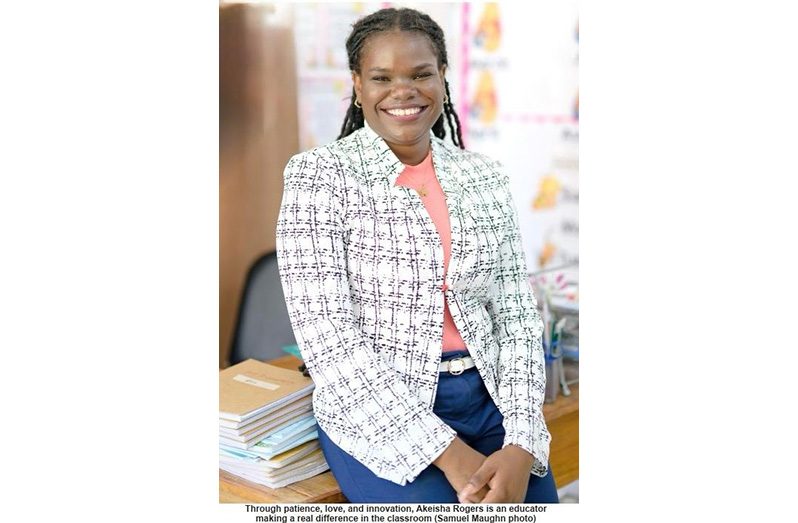At the Schoonord Learning Centre, Ms Rogers combines patience, creativity, and dedication to help children with disabilities thrive
AS Guyana celebrates Education Month, teacher Akeisha Rogers exemplifies this year’s theme, “Quality Education for National Development.” Speaking to Pepperpot Magazine from the Schoonord Learning Centre for Diverse Needs, where she has been working for the past three years, Akeisha Rogers discusses the challenges, daily routines, and creative ways she helps her students learn and grow. Through patience, love, and innovation, she is an educator making a real difference in the classroom.
Young, vibrant, and passionate, Ms Rogers did not begin her career working with children with disabilities. Originally striving to become a primary school teacher, she was hesitant when asked to teach at the Schoonord Learning Centre for Diverse Needs, but took the opportunity.
“It wasn’t really my plan to be here because I was trained to be a primary school classroom teacher. However, the school was a bit full, and I got a call, and it was like, ‘Hi, are you interested in teaching at a special needs school?’ At first, I was very nervous, and then I eventually said yes,” she stated.
That yes would lead her to a classroom very different from what she was used to, but she would soon fall in love with it.
“When I came here, it wasn’t a usual classroom setting where it’s chalk and talk, and you stand in front of the classroom and have a full-on conversation. It’s more about having patience, finding new ways to put over your lesson. It was very difficult at first, but eventually, I gained that patience and that comfort in my classroom, and now I’m working with autistic children.”
While days in any classroom are hectic, for teachers like Ms Rogers, it can be especially chaotic. Working with children with autism requires specialised teaching tactics and a calmer-than-usual approach. Ms Rogers adapts her teaching style and classes to suit her students.
“If they like painting, I have to find something that relates to painting so I can put over my lesson. I have a child who likes to sing. I sing a lot. I don’t know what I’ll be singing sometimes, I don’t know where I’ll find the lyrics, but improvisation—I have to improvise on my songs and everything,” she stated.
Arriving every day at 7:25 a.m., Ms Rogers says her days start with greeting children with either a handshake or a hug and ensuring they are comfortable and ready to start class.
“In the beginning of all lessons, I have to sing. I have to calm them down. If they’re not comfortable in the classroom, I have to take them outside. I have to give them that break, or we have a sensory stimulation room where they can climb ladders, probably watch TV, experience a bit of light changing and these things. From that, we usually have our break. We eat.”
Even lunch is a bit different in Ms Rogers’ class. Ensuring that her children are always comfortable, she gives up the classic utensils and teacher’s desk to join her students on the floor with a unicorn lunch kit.
“I usually sit together. I have a lunch kit because everything needs to be more of a skill. So I have a little lunch kit with a little unicorn in it, and I sit amongst them and show them how to open the lunch kit, how to open the water bottle, and try to be a role model for them so they can follow me,” she explained.
Ms Rogers also does plenty of work comforting parents. For many parents of children with disabilities, school can be a daunting thought for both them and the children. But as she shares, although difficult at first, children do get comfortable in the classroom with a little extra support.
“It’s just like when your child is now starting nursery, they’re going to cry, they’re going to throw a tantrum. So what we do is invite mummy or the parent into the classroom, let them see the setting and what it’s usually like, give them a run-through,” she said.
Apart from fears, misconceptions are another hurdle. Many people—and parents of children with disabilities—see learning as impossible. But Ms Rogers says not only can children with disabilities learn, they can become important additions to society and live and work like anyone else.
“A lot of parents usually have the mindset that, okay, my child has a disability, and they’re not doing the things that a normal child would, and they won’t learn. I totally disagree with that because they’re very, very intelligent. They don’t process information like a normal child would, but they process it a bit slower. Eventually, they get it. I totally believe they can do so many things.”
That belief is why the Schoonord Centre ensures that their children are equipped with a number of skills outside of academics. The school is home to an agri-plot and has a number of clubs for children to join.
“We try to implement a lot of life skills where we have the chicken pen. We have a garden sport. I personally do hair and nails, more of a cosmetology club with the children. We have robotics. We have so many things for them to explore, and we find what they like and we work on that. So eventually, they can do something or leave here with something.”
Moving forward, Ms Rogers would like to see more emphasis placed on training teachers outside of academics. A cosmetology specialist, she says that the skill has helped her in her classroom and thinks that training other teachers in a similar field could make a big impact.
“What I usually do as a teacher is try to train myself first before I come to teach the children. So, for example, I do a cosmetology club. The school has different clubs, and what we as teachers did is teach ourselves first and then we bring it into the classroom. So if we could have workshops continuing on how to build ourselves to bring it into the classroom, that would be totally appreciated.”
For Ms Rogers, teaching is not just about imparting knowledge but also about learning alongside her students.
“Teaching and working with my class has impacted me. I have grown so much. It has also helped me with motherhood. I’m a mum of one, and the patience and being around these children has improved my personal life,” she stated.
The classroom becomes a space of mutual growth, where educators and learners alike explore, adapt, and discover new ways of understanding the world. Her experience reinforces the notion that education is a lifelong journey—one that requires patience, creativity, and a willingness to embrace challenges as opportunities to grow.



.jpg)








